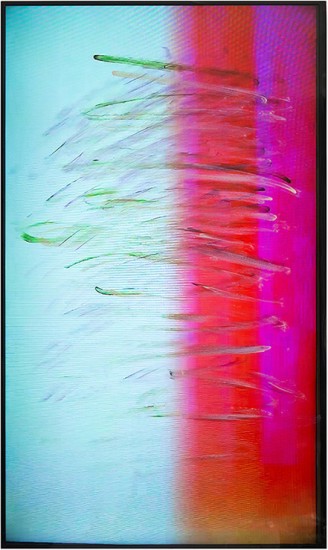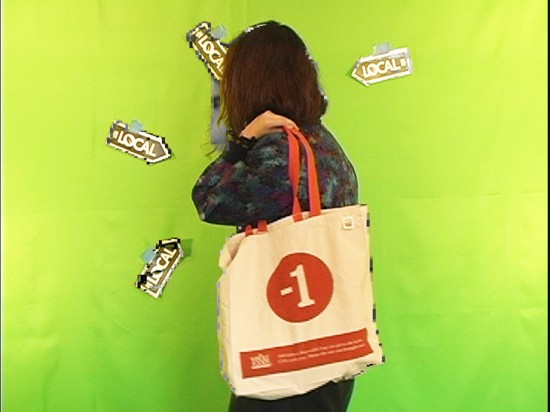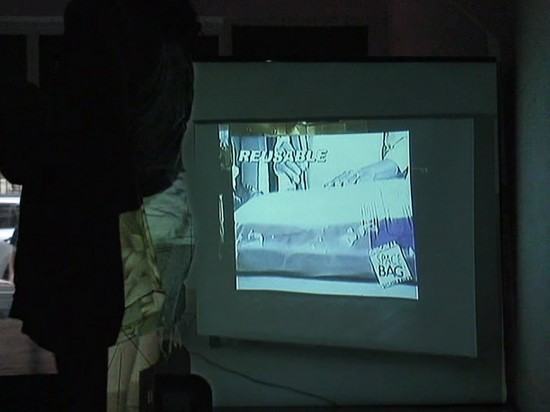AB/EX/IN/AMB/OM
By Andrew Maerkle
 gesture/data (feedback) (2015), oil paint on flat-screen television,
gesture/data (feedback) (2015), oil paint on flat-screen television, mp4 file (color, silent) and feedback mp4 file (color, sound). All
images: Unless otherwise specified, © Ken Okiishi; courtesy the
artist and Take Ninagawa, Tokyo.
Born in 1978 and currently based in New York, Ken Okiishi draws upon a wide range of cultural and topical references in making his works, which can take the form of anything from more-or-less straightforward videos to multimedia installations and performances, but which each reveal the complex interactions between media and subjectivity. In (Goodbye to) Manhattan (2010), for example, Okiishi took the German subtitles for Woody Allen’s Manhattan (1979), and retranslated them back into English using Google Translate. This new text then served as the script for a film by Okiishi, which was overcut with Allen’s original, as well as new footage. Other works have peered into Marcel Duchamp’s former Manhattan studio using the real estate search engine Streeteasy.com, or combined video feedback loops with live piano performances. More recently, Okiishi has explored the expressive implications of the flatscreen digital interface technology that is now omnipresent in developed societies. For the series “gesture/data” (2013- ), Okiishi paints directly upon the surfaces of flatscreen monitors, which in turn play back television footage that has gone through several generations of recording, reformatting and reprocessing. The marks left by the paint evoke both the characteristic residue left by innumerable finger “swipes” on smartphone and tablet screens, and also reinvent diverse traditions of painting, from Chinese and Japanese calligraphy to Abstract-Expressionism and latter-day gestural abstraction and figuration. In the interaction between paint and monitor, the interference itself becomes the “content.”
Okiishi was recently in Tokyo for the opening of his second exhibition at Take Ninagawa gallery, where he showed works from his latest project, “gesture/data (feedback)” (2015), in which an additional layer of distortion is added to the “gesture/data” concept by including, among the original television material, footage that has been shot of the painted work itself. This creates an uncanny doubling effect, by which the paint seems to move between the interior and exterior of the screen. ART iT met with Okiishi prior to the opening of the exhibition to discuss his work, and how it relates to his interest in both language and in music, in greater detail.
“gestures, data, feedback” was on view at Take Ninagawa from September 5 to October 24 of this year.
I.
 Still from (Goodbye to) Manhattan (2010), video, color/sound, 72 min.
Still from (Goodbye to) Manhattan (2010), video, color/sound, 72 min.
ART iT: I’d like to start with an anecdote you might appreciate: The other day I was at a neighborhood café where the only other customers were an older Western man and a middle-aged Japanese woman doing a language exchange. They must have been discussing current events, when suddenly the man started explaining about how, owing to the ancient Greek settlements there, much of the population in Syria are fair-skinned, and how in North Africa as well, there are many fair-skinned populations that descend from colonies like Carthage. This led him to describe the Punic Wars between Carthage and Rome, and the great warrior Hannibal, after which he brought up the darker-skinned Berbers, so-called from the Greek barbar, a pejorative onomatopoeia for babbling or foreign speech–also the root of the English “barbarian.” In the meantime, when the conversation turned to Japanese, the topic switched to food.
It was fascinating to encounter this obsolete, racially and gender coded ordering of knowledge in the context of a language exchange in a café in Tokyo. There was a rupture in the supposedly “informal” form of the language exchange, which exaggerated its underlying pedagogic structure. I think in an oblique way these ruptures between language and medium or context, and how we embody knowledge, are something your works touch upon. What do you think?
KO: Rupture is very difficult to talk about, and that’s part of what interests me about it. In a rupture, you are approaching something that is also in the process of decomposing or deforming. I think one of the frames for thinking about rupture in my current work, but also in the past work as well, is very simply to think about what is inside and what is outside. The moment that dynamic becomes confused or starts to feed back into itself, such as in the dialogue you describe, it could start to feel like it’s going in one direction, but then it’s also flowing back in the other direction. Suddenly it becomes something else, not only as it shifts languages, but also in the sense that people are speaking who don’t necessarily understand each other. There’s an attempt at communication across a barrier, but the barrier is always present, and can never be fully traversed. In that sense, it’s a rupture that is also not a rupture. Nothing actually breaks. No matter how close you get, there is always some kind of separation.
I once had a job teaching English, and teaching how to write it at an academic level, to people who didn’t necessarily have a strong background in English going into college. There was a funny thing that some of the other teachers would do, which was to re-mystify concepts by trying to explain them in a way that would be hard to understand even for native speakers. The more they tried to work around the communication gap, the more they would produce distance to the language. Instead of getting more concrete, they would get more abstract. This tendency for the gap to generate more and more abstraction instead of concreteness is really interesting to me.
ART iT: Is that similar to what happens in your film (Goodbye to) Manhattan (2010), for which you used Google Translate to bring the German subtitles for Woody Allen’s Manhattan back into spoken English?
KO: Yes, exactly. Google Translate was particularly extreme because it was so systematized. But it changed. It used to operate as a rule-based, algorithmic translation, and now it is statistically based. A simplification of what happens is that the translating machine chooses the most likely translation–not necessarily the correct one–and there are these enormous databases working to get the translation more and more perfect. So the newer translation may seem smoother, but a lot of the time it’s incorrect.
I actually had this experience with friends in Germany where, because they spoke so fluently, it seemed like they understood everything you were saying in English, but actually there was a lot of miscommunication happening. I think with Google this translation system became an external way to produce that effect in language or between languages, which also connects to the same systems that are used for the ordering of search results. It’s based on figures, but also on who’s paying whom to improve the search ranking, or who’s a better programmer, because if you can link your site to enough other sites, then your page automatically becomes the top hit.
The same kinds of control systems are involved in these different processes, but language is the most intimate of those encounters with another person. The old algorithmically based translation system would make visible these ruptures in language–where it becomes nonsense–but I liked the jokes that could happen there, the new language. One of the things I also liked in language teaching was that you could enter into those mistakes. You can enter into the funny things that happen when you translate too literally, and then when you remove all those parts and explain why the translation doesn’t work, it starts to open up how grammar operates, and an understanding of grammar develops out of that. It’s not about teaching a set of rules. When you teach a set of rules, you end up with a bad translation.
ART iT: What got you interested in working with language in the first place?
KO: My family was very expressive. We talked all the time. It comes from my mother. She’s the kind of person who doesn’t change her vocabulary when she talks with children. And then on my father’s side, there were always these gaps in language in general, related to his being Japanese-American living in Hawaii before, during and directly after World War II. During the war, when my father was a child, they were basically forbidden from speaking and “acting” Japanese. This bled in all kinds of difficult ways into the immediate postwar period, when my father was a teenager. But, at the same time, because there were so many different cultures there, from native Hawaiian to Portuguese to Chinese, Filipino, Japanese, and English as well as Samoan–basically whoever ended up there somehow–there was an amazing pidgin that developed.
Pidgin is fascinating because it doesn’t have a logical grammar. It’s a way of speaking that emerges naturally between languages and never gets ordered through a grammar or spelling system. My father grew up learning standard American English, but among his friends he would speak pidgin, which they called “Da kine.” I can’t really do it, but, for example, if you were about to get into a fight, you would say, “You like beef o’ what,” meaning, “Do you have a beef, do you want to fight?” I guess these were 1950s high-school semi-gangster expressions that occurred between all these people speaking different languages in the same place, and at a time right before Hawaii became a state.
So if you want to read it psychologically, I think it comes down to that relationship between educated English on my mother’s side, and both educated English and repressed Japanese, as well as early-American multi-cultural pidgin, on my father’s side. I would say the simultaneity of those different kinds of language in my life–both as presence and absence–is what initially motivated my interest in language.
 Performance documentation of Vorstellungsklavier (2007-2009) on its third iteration, at Ludlow 38, New York, June 8, 2008.
Performance documentation of Vorstellungsklavier (2007-2009) on its third iteration, at Ludlow 38, New York, June 8, 2008.ART iT: Pidgin is an interesting metaphor, because I think your works explore the ambiguous, undefined space between binary relations. With the “gesture/data” work, for example, it’s neither a painting nor a video, it’s a. . .
KO: It’s hard to find the word. You have to hesitate to find the word, and producing that hesitation is something significant. There’s also a lot of rupture in form from one period of time to the next. The original base footage I was working with in these “works”–which I think is the only general category that really applies to them right now–comes from VHS tapes of recorded TV shows that I found in my parents’ basement.
I first used the footage for a performance in 2007 at Gavin Brown’s Enterprise in New York, Vorstellungsklavier, where I projected it onto the back of a piano as I was playing things such as a Schubert sonata, or classical chamber music, and recording the whole thing on video. Following the first instance, I repeated the performance in different contexts and kept rerecording over the original footage with each iteration. The performance encapsulated this element of the old-fashioned instrument and the different context of chamber music ruptured into the kind of gatherings that happen inside galleries, and then the old TV footage. Gatherings at galleries are always just like being at a bar anyways, and somehow when you’re at a bar with the TV on, all you can do is watch the TV. So those two things were happening at the same time.
It’s hard to explain. Music is one of those places where the ability to describe things through language really breaks down. A lot of times when you describe music, you end up speaking in clichés–feeling happy, feeling sad, sublime. But this was an interesting situation because it was mixed with the crass form of TV, accentuating the distance between them.
From there, I started using the same footage by playing it back on a television screen and then using the television as a painting surface. I think there’s a parallel between the rupture from one mode of live, public performance into another private mode that is based on actions and reflections.
Ken Okiishi: Ab/Ex/In/Amb/Om
